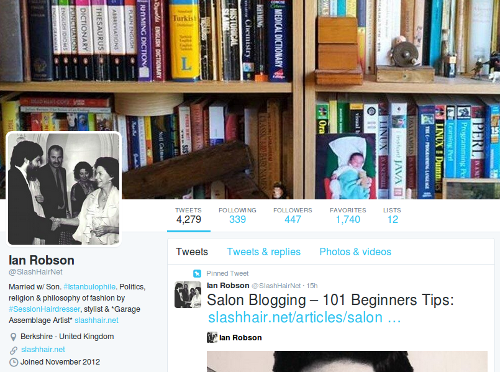
Above is my Twitter profile page @SlashHairNet – Caveat: don’t do it like me, this is just an example!
A Beginner’s Guide
I know it’s an obvious thing to say, but, your twitter profile can say an awful lot about you – Make it all good! Let me take you by the hand and lead you through your salon’s twitter profile; I’ll show you something to make you change your mind.
It is important to remember that your twitter profile will be viewed in different ways: obviously as a full page, but also as a pop-up Profile-Card when someone hovers over your avatar or name, and also as a Stream-Item within a List!
 Twitter Profile-Cards ^
Twitter Profile-Cards ^

My SlashHairNet Stream-Item within a List ^
Header Photo
The header photo is the big one at the top (original image size: 1500px × 500px). Tell your story and make it personal; try not to go all product sales-y, massive logo-y and Web-address-y ~ by which I mean, don’t sell, sell, sell!
Profile Photo
In the old days this was called your avatar! And was an important element within branding, however these days, I think your profile photo (original image size: 400px x 400px) is a straightforward way to give your salon’s twitter profile a distinctive personal touch. Instead of opting for a logo, choose a recognisable photograph of the person who runs the salon’s twitter account – may have very positive real world benefits too. Never use twitter’s own egg avatar.
Profile Name & Username
My Twitter name is Ian Robson – it can be changed as and when the mood suits! However, your profile name should be your salon’s name!
My Twitter username is @SlashHairNet – it can’t be changed! Your profile username should be your salon’s name!
BTW, Namecheckr is a handy social username availability checker.
The Bio
What’s important about the bio is that everyone who visits your Twitter page, sees your Profile-Card or Stream-Item will read your bio; but more importantly, everyone who’s thinking of following you will read it too – so it’s got to be expansive.
You are allowed 160 characters, use them, include as much information as possible.
Bios shouldn’t be static, they need to be regularly updated and ‘of the now’ and just like a CV if anything changes, change the Bio.
Here’s a Bio formula: [URL] + [YourName] + [Description] + [Hometown/Location] + [Call-To-Action]
URL [http://SlashHair.net/]
Important: include a link to your website from within the bio text. When your Bio appears within a Profile-Card or a List, people will be able to click the link to your website.
If your URL is miles too long, you can shorten it with Bitly – You can modify the random character ending into something more recognisable by signing up!
Should you need to create a new Twitter account? Link to your New twitter account, from the Bio of your Old Twitter account, simply by including your new username.
YourName [Ian Robson]
Unless there are issues with your salon’s name I wouldn’t bother including it within your bio text. However, if you have a guest tweeter you should always include their name – people love to know who they’re talking to.
Description [The ‘blurb’]
Here is where you get expansive and creative. It’s important to give an idea of who you are, what you do & what you’re about. I suppose all you must do is write a classic strapline! 1: Tell people what you do & what you’re about which answers their Why? 2: Keep it short and simple. 3: Include your call to action.
Don’t use emojis or special characters within your descriptive text.
Hometown/Location [King’s Road, Chelsea?]
There is a ‘profile field’ where you can set your location (eg. London), additionally you can include King’s Road &/or Chelsea to give a more accurate location within the bio. Location can be seen as a selling point ~ think about this point!
Call-To-Action [Subscribe to our blog]
Your call to action should be positive ~ Your hair sucks, we can fix it – if you get my drift? Just don’t write: ‘buy now’ or ‘click here’. The World’s best CTA by far is Nike’s, Just Do It.
#HashTags
Simply by prefixing “#” to Hairdresser (#Hairdresser) you’ve created a hashtag – but you already knew that didn’t you. #HashTags are another way to be found within Twitter search!
Hashtags are used for grouping conversations together, eg. for a Twitter Chat. Potential clients aren’t going to find you if you use a #UniqueHashTag – you’ve got to second-guess what they are going to search for to find you. And you can only do that if you understand your clients and your target audience.
